|

 Explorers, Scientists &
Inventors
Explorers, Scientists &
Inventors
 Musicians, Painters &
Artists
Musicians, Painters &
Artists
 Poets, Writers &
Philosophers
Poets, Writers &
Philosophers
 Native Americans & The Wild
West
Native Americans & The Wild
West
 First Ladies
First Ladies
 Popes
Popes
 Troublemakers
Troublemakers
 Historians
Historians
 Archaeologists
Archaeologists
 Royal Families
Royal Families
 Tribes & Peoples
Tribes & Peoples

Assassinations in History
Who
got slain, almost slain, when, how,
why, and by whom?
 Go to the
Assassination Archive
Go to the
Assassination Archive




Online History Dictionary A - Z
All-Time Records in
History
What was the
bloodiest battle, the battle with the least
casualties, who was the greatest military leader?
 Go to
Records in History
Go to
Records in History
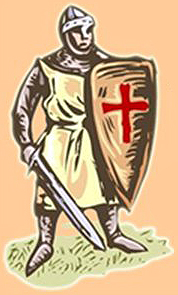

 Timeline of the War of 1812: Year 1812
Timeline of the War of 1812: Year 1812
 Timeline of the War of 1812: Year 1813
Timeline of the War of 1812: Year 1813
 Timeline of the War of 1812: Year 1814
Timeline of the War of 1812: Year 1814
 Timeline of the War of 1812: Year 1815
Timeline of the War of 1812: Year 1815
:: Human Rights in History ::
A Timeline
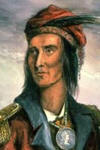
Tecumseh 1768-1813
|
|

The Original Lone Star Republic:
West Florida for 74 Days in 1810
West Florida Revolt 1810
The
West Florida Revolt of 1810 was
fought for independence from Spain
and the establishment of the
free
 Republic of West Florida.
Republic of West Florida.
|
|
Rebellion or Revolt?
Was the Florida Revolt of 1810 a
rebellion or a revolt?
It was a proper revolt. The Spanish
authority was overthrown by an armed insurrection.
Image Above
Left: Map outline of today's State of
Louisiana, including in darker color the modern eight so-called
Florida Parishes, which derive
their name from the
 colonial province of West Florida:
colonial province of West Florida:
East Baton
Rouge Parish, West Feliciana Parish, East Feliciana Parish, St. Helena
Parish, Livingston Parish,
Tangipahoa Parish, Washington Parish, and St. Tammany Parish
And yes, Louisiana has parishes, not
counties. Another legacy from Catholic French and Spanish rule back
in the days.
Right: Original Lone Star Flag of the West Florida
Republic
Who Exactly Fought in the West Florida Revolt?
Feliciana county settlers (today's
Florida Parishes, then the westernmost part of Spanish West Florida,
see map below) fought their Spanish landlords.
Among these settlers
were many British loyalists and American deserters.
The Spanish governor of West Florida
at the time was Vicente Folch.
The capital of West Florida was Pensacola.
|
When Was It
Fought?
The West Florida Revolt was fought
from September 23 to October 9, 1810.
Who Won? Who Lost?
Short term winners of this revolt were
the rebels, who enjoyed their independent
Republic of West Florida for 74
days.
Long term winners of this revolt was a
third party, the United States, who took advantage of the commotion
and annexed the territory outright. This in turn led to
the speculation (now proven) that the uprising had been at least in
part encouraged by the American
government.
Spain lost the Floridas (West and East
Florida) in slices. By 1819, it was all gone (see
 Transcontinental Treaty). The Native Americans meant to send
their condolences, but apparently, someone had stolen their
letterheads.
Transcontinental Treaty). The Native Americans meant to send
their condolences, but apparently, someone had stolen their
letterheads.
The Republic of West Florida
The Republic of West Florida lasted from September 26 to December
8, 1810. It reached from the Mississippi to the Pearl River, had a
flag, an assembly, a governor, governing officials, an army, and a constitution, which,
by the way, was pro-slavery but religiously tolerant.
You can examine the original copy of the Constitution of the
Republic of West Florida, which is housed in the Louisiana State Archives
at
Baton Rouge. It was placed there in 2002 by Leila Lee Roberts, the
great-granddaughter of Fulwar Skipwith.
Back to 1810.
The boundaries of the Republic of West Florida and of West
Florida were not the same. The
Republic of West Florida reached from the Mississippi to the Pearl
River. West Florida reached from the Mississippi to the Apalachicola
River. See
here:

Border Line of
the Republic of West Florida 1810
Click to
enlarge
Background of the West Florida Revolt
It is amazing how many times in history the root of disagreements
can be traced back to a big ego from Corsica.
On June 6, 1808,
 Napoleon placed his brother
Napoleon placed his brother
 Joseph Bonaparte on the Spanish throne,
which had formerly been occupied by Spanish
King Ferdinand VII. To
make sure Ferdinand stayed away from the coveted chair, Napoleon
locked him up.
Joseph Bonaparte on the Spanish throne,
which had formerly been occupied by Spanish
King Ferdinand VII. To
make sure Ferdinand stayed away from the coveted chair, Napoleon
locked him up.
The people of Spain were shocked and outraged, as were the people in the Spanish colonies.
But there, they went a step further.
In the colonies, this crisis of authority led to unrest, and the war
for independence from Spain gained momentum.
The monarchy dissolved and Spain lost — Are
we not in the position of children who come
of age at the death of the father of the
family?
Each one enters into the enjoyment
of his individual rights, sets up a new
hearth, and governs himself.
Camilo Torres, revolutionary in New Granada
(today's Colombia, Panama, Ecuador, and
Venezuela)
Observing these developments, U.S. President
 James Madison acted swiftly
and called dibs on the Floridas:
James Madison acted swiftly
and called dibs on the Floridas:
Sir: According to present appearances a crisis is approaching which
cannot fail to dissolve the Colonial relation of Spanish America to
their parent Country.
It is the duty therefore of the United States to
turn their attention particularly to the case of the two Floridas in whose
destiny they have so near an interest. Besides that which results from
Geographical position the United States consider themselves as holding a legal
title to the greater part of West Florida under the purchase made by the
Convention with France in the year 1803. And they have a fair claim of another
kind, which would certainly not be more than satisfied by the acquisition
of the residue of the West and the whole of East Florida.
Under these
circumstances it may be proper not to conceal from the British Government
(which may otherwise form views towards these territories inconsistent with
the eventual ones entertained by the United States) that any steps on
the part of Great Britain interfering with these will necessarily be regarded
as unjust and unfriendly, and as leading to collisions, which it must be the
interest of both nations to avoid.
This instruction from the President is given to you on the
supposition that the connection of Great Britain with Spain will have been terminated
by events in Europe. You will of course forbear to execute it in a
different state of things. And in executing it you will be careful to
authorize no inference with respect to the intentions of this Government
inconsistent with the principles of justice and neutrality on which the policy of the
United States is founded.
With great respect [etc.]
Letter from Robert Smith,
Secretary of State,
to William Pinkney, United States Minister to
Great Britain
Washington, June 13, 1810
The very next day, on June 14, 1810, President Madison met with the Governor of the
Territory of Orleans, William C.C. Claiborne. This meeting compelled
Claiborne to write the following letter, asking for a revolt:
[...] You know, that under the Louisiana
Convention, we claim as far eastwardly as
the Perdido. That claim never has, and never
will I trust, be abandoned. But I am
persuaded under present circumstances, it
would be more pleasing that the taking
possession of the country, be preceded by a
request from the inhabitants.
Can no means be devised to obtain such
request?
The time may arrive, perhaps it has arrived,
when the people of Florida must adopt
measures with a view of their present and
future security. [...] to form for
themselves an independent government is out
of the question!
[...] Nature has decreed the union of
Florida with the United States, and the
welfare of the inhabitants imperiously
demands it.
[...] and therefore it is, that I, with the
more confidence, invite you to lose no time
in sounding the views of the most
influential of your neighbors on the
opposite shore, and in giving to them a
right direction.
[...] Impress upon their minds the
importance of the crisis, the expediency of
scouting everything like French or English
influence, and assure them, I pray you, of
the friendly disposition of the American
government.
I am aware that among the settlers of
Florida, there are persons, who during the
American war were disaffected to the United
States, and who, probably, may feel some
uneasiness at falling under the American
government. It may be well to quiet their
apprehensions by informing them that the
transactions of that day will not be
remembered to their injury, that the present
is a fit occasion to return to the bosom of
their country, and, if embraced with
cordiality, the prodigal son mentioned in
holy writ did not meet a more heartfelt
welcome than they would experience from the
American family. [...]
Excerpts from a letter from William C.C. Claiborne, Governor
of Orleans Territory,
to William Wykoff, Jr., a judge who owned a
cotton plantation opposite Baton Rouge
Washington, June 14, 1810
Historians have difficulties to ascertain to what extent the U.S.
government managed to encourage the West Florida revolt, and to what extent it
evolved naturally.
Fact is that the American stance that "an independent government"
was "out of the question" was not shared by all rebels.
Thus, the West Florida Revolt unfolded as follows:
Timeline of the West Florida Revolt
::
July 14, 1810
A group of West Floridian planters are unhappy with their Spanish
government in general and their governor
Don Carlos de Hault de Lassus (also spelled Carlos
Dehault Delassus) in particular. Today, they voted fourteen men as their
representatives who will assemble as a convention with the goal to aid the
governor in his duties.
De Lassus never asked for any help, but he doesn't have the manpower
to put the settlers in their place in case they wouldn't take no for
an answer. So this election of a convention
took place with his permission in order to buy time. He secretly sent for armed help from Vincente Folch
to restore his authority.
::
July 25, 1810
The Convention meets at St. Johns Plains near Baton Rouge. After
pledging allegiance to Spanish King Ferdinand VII, they list their
goals and grievances.
:: August 22, 1810
After weeks of deliberation, the Convention passed today their
resolutions as an ordinance for future implementation, all in all 32 pages long, with only one dissenting
vote. Governor De Lassus also added his signature. All seems well.
::
September 20, 1810
One of Delassus' letters to Folch, in which he asks for immediate
help to suppress this assault on his authority, is intercepted by
convention supporters. The Convention now has proof of Delassus'
double dealing.
:: September 22, 1810
The Convention meets at St. Francisville. Delassus is condemned as a
traitor. The men realize that if anything needs to be done, it
should be done quickly before Folch's troops arrive from Pensacola.
Philemon Thomas, commander of the local militia, is put in charge of
capturing the Spanish Fort San Carlos
(formerly British Fort Richmond) at Baton Rouge in the name of the
Convention.
The West Florida Revolt Begins
::
September 23, 1810
Shortly before 4 AM, approx. 75 armed rebels led by Philemon Thomas,
colonel of the militia, storm
the Spanish fort at Baton Rouge. They capture the fort quickly,
disarm the defending Spaniards (including Governor De Lassus) and
raise their flag.
::
September 25, 1810
The Convention dispatches Edmund Hawes to talk to the inhabitants of
the St. Helena and St. Ferdinand district, who were not on board
with the revolution. In fact, there, the majority of residents were
pro-Spanish, and these forces organized themselves to strike back.
The Independent Republic of West Florida
Declared
:: September 26, 1810
The Convention assembles at
Baton Rouge and declares West Florida to be free and independent
from Spain.
::
September 29, 1810
The Convention asks all planters to send slaves to assist in repairs
on the fort.
The Convention charges Philemon Thomas with the task to quell any
potential counter-insurrection in the pro-Spanish St Helena district.
::
October 9, 1810
Thomas and about 400 men cross the Amite River. Some of the
pro-Spanish individuals sign the Declaration of Independence, others
flee to New Orleans.
The West Florida Revolt Has Ended
::
October 10, 1810
The Convention puts
Reuben Kemper and
Joseph White at the head of the new Convention
Army. Their task is to advance against Mobile, Alabama, and thus to extend
their territory to the Perdido River.
::
October 27, 1810
President Madison issues a
 proclamation annexing West Florida, from
the Mississippi not only to the Pearl River, but all the way to the Perdido River, stating that this is U.S.
territory because it had been part of the
proclamation annexing West Florida, from
the Mississippi not only to the Pearl River, but all the way to the Perdido River, stating that this is U.S.
territory because it had been part of the
 Louisiana Purchase of 1803
all along.
William C.C. Claiborne, Governor of the Territory of
Orleans, is dispatched to see this through.
Louisiana Purchase of 1803
all along.
William C.C. Claiborne, Governor of the Territory of
Orleans, is dispatched to see this through.
Thus, the
West Florida Revolt of 1810 got
mixed up in the
 West Florida Controversy
that exists between the U.S. and
Spain.
West Florida Controversy
that exists between the U.S. and
Spain.
::
November 22, 1810
The Convention elects Fulwar Skipwith
Governor of State.
::
December 1, 1810
Claiborne arrives in Natchez. Capt. John Shaw, leading five vessels
down the Mississippi, will provide naval support for the impending
invasion.
Col. Leonard Covington will lead 300 troops from Washington (Mississippi
Territory) to Pointe Coupee, located across the Misssissippi
River from St. Francisville. There, Covington will meet up with
Claiborne.
Col. Pike will led the rest of the army in the Mississippi
Territory.
::
December 2, 1810
Claiborne gets intel that Skipwith is gathering his troops.
He orders Covington to increase his army to 800 troops.
::
December 4, 1810
Claiborne writes US secretary of state
Robert Smith "you may be
assured that no blood will be shed, if it can possibly be avoided."
Claiborne orders the American garrison at Fort Stoddart, near
Mobile but Mississippi Territory, to be good and ready just in case.
He then leaves for Pointe
Coupee.
Here is Pointe Coupee across the river from St. Francisville:
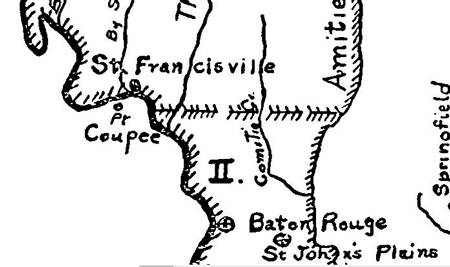
Map Location Pointe Coupee, St Francisville,
and Baton Rouge
Click to enlarge
Or maybe this map:
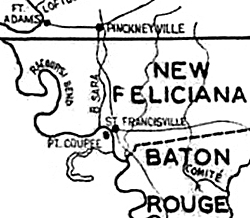
Western West Florida 1810
Click to enlarge
::
December 6, 1810
In the morning, the Governor of the Mississippi Territory,
David Holmes, visits St
Francisville where he meets Skipwith and the Florida assembly in
session. Claiborne reports in a letter to Robert Smith:
The president's proclamation had previously
been circulated among the citizens of St.
Francisville, and had become the subject of
general conversation. Dissatisfaction as to
its tenor was expressed by several members
of the assembly, and some citizens ; but Mr.
Skipwith in particular took great
exceptions. Govr. Holmes gave such
explanations, as were believed to be
satisfactory to most of the former persons;
but Mr. Skipwith continued dissatisfied, as
in the afternoon of yesterday he returned to
Baton Rouge, accompanied by three or four
members of the Florida Legislature, where it
is understood, the whole corps are to
assemble on Tomorrow.
::
December 7, 1810
Claiborne arrives at Pointe
Coupee, where he joins the Governor Holmes, and
Audley L. Osborn (a lawyer who
will become the first judge of the St. Helena Parish).
Arriving from across the river is John H. Johnson, a
member of the West Florida Convention, who assures Claiborne of his
pro-American inclinations, but, citing further from Claiborne's
above mentioned letter,
then said, that Mr.
Skipwith had also charged him to inform me
verbally, that he had retired to the Fort of
Baton Rouge, and rather than surrender the
Country unconditionally and without terms,
he would with twenty men only, if a greater
number could not be procured surround the
Flag Staff and die in its defense.
To this message I made
no reply, but requested Mr. Johnson to
repeat it; which he did.
Mr. Johnson again took
occasion to express his devotion to the
Government of the United States, and urged
me to visit immediately St. Francisville
where I would find a Militia Troop of
Cavalry, a company of Riflemen, and a
concourse of Citizens, who would welcome my
arrival, in the Territory, and with pleasure
recognize me as their Governor.
Claiborne sends Osborn to assess the actual level of hospitality he
would likely encounter in St Francisville.
End of the
Independent Republic of West Florida
:: December 8, 1810
Osborn returns from St Francisville and reports to Claiborne that he
would be favorably received. Claiborne and Holmes cross the river.
The citizens of St Francisville met them at the beach and the
companies of cavalry and riflemen escorted them to the town. And
again from Claiborne's letter:
There I saw a pavilion waving which was said
to be the Colors of the State of Florida.
The Militia being required to form round the
flag staff, I appeared in the center, and
the president's proclamation being read by a
Citizen, I said to the Militia, that having
come among them as their Governor and
commander in Chief charged by the president
of the United States to protect them in the
enjoyment of their liberty, property and
religion, I had only to observe, that it
would be my pride and glory to discharge
with fidelity so high a trust.
The Florida flag was then ordered by me to
be taken down, which was done, the Militia
and Citizens cheering (as a mark of respect)
as it descended. I then ordered a flag of
the United States, which I had. taken from
my barge to be reared, which was also done
amidst the huzzas of the Militia and
citizens.
Which only leaves the slightly tougher nut to crack, Skipwith and his
men in the fort at Baton Rouge. Continues Claiborne,
No efforts which my Country's honor or my
own permit, will remain unessayed, to induce
Mr. Skipwith to abandon his ill-judged and
rash purposes : Nor am I without strong
hopes of succeeding. But if conciliatory
measures should obstinately fail, the troops
of the United States will be commanded to
take the fort.
Claiborne gets ready to move on Baton Rouge, while waiting for Capt. Shaw and his
gun boats to arrive at St Francisville.
::
December 10, 1810
It's 3 PM and
Claiborne takes the fort at Baton Rouge. In his own words:
From the information
previously received I certainly had reasons
to apprehend resistance, and was prepared to
meet it.
But on landing near
the Town the agreeable intelligence was
brought me that the armed Citizens (called
here the Convention Troops) were ready to
retire from the Fort, and to acknowledge the
authority of the United States. It was not
understood by me that terms were insisted
on.
But a wish was
expressed that the Florida flag might be
treated with respect, and the deserters
unmolested. In answer I requested that the
Fort might be evacuated at half past two
o'clock, and that the citizens should march
out and stack their arms.
As related to the
Florida flag I readily assented that on
striking it, such evidences of respect might
be shown, as the armed citizens in the Fort
thought proper. And with regard to the
deserters I stated, that they should remain
undisturbed until the president's pleasure
respecting them should be known.
This arrangement was
satisfactory, and the Fort being evacuated
in the manner and at the time proposed, it
was taken possession of at three o'clock by
a Detachment of the United States Troops.
West Florida Maps

Acquisition of West Florida 1767-1819
Click to enlarge

Floridas, The - East and West Florida 1765
And here are two US expansion maps, 1800 and 1810 respectively:
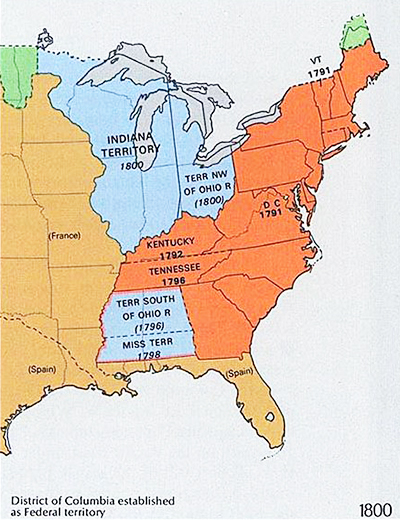
Map of U.S. Expansion in 1800
Spain abandoned her claims on the land strip
between the 31st parallel and 32nd 28' with the
Treaty of San Lorenzo in 1795. The U.S. made it
their Mississippi Territory in 1798. The rest of West Florida is in
Spanish hands.
Click to enlarge

Map of U.S. Expansion in 1810
West Florida from the Mississippi River
to the Perdido River claimed by the U.S.
Click to enlarge
Here is more about the history of
 West Florida.
West Florida.
Here are the men
 who governed the Republic of West Florida
in 1810.
who governed the Republic of West Florida
in 1810.
And here is the
 list of all governors of the colonial
province of West Florida from 1763 to 1821.
list of all governors of the colonial
province of West Florida from 1763 to 1821.
More History
|